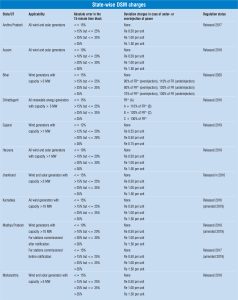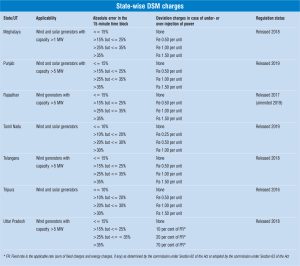India is rapidly expanding its renewable energy portfolio to achieve its ambitious goal of 500 GW of non-fossil-fuel-based energy by 2030 and net zero emissions by 2070. As the proportion of clean energy is increasing significantly in India’s energy mix, there is a need to develop and introduce regulations for forecasting and scheduling, as well as a deviation settlement mechanism (DSM) for renewable energy sources such as solar and wind. In recent years, the Central Electricity Regulatory Commission (CERC) and various state electricity regulatory commissions (SERCs) have issued guidelines for forecasting in the industry. These help regulate the amount of electricity injected into the grid and provide a system to penalise power plants for deviating from scheduled generation beyond a specific limit.
Under these regulations, renewable energy producers are required to predict and set a generation schedule to their respective load despatch centres, which can be modified as needed. This is particularly crucial in states that experience extreme weather conditions and have a high proportion of renewable energy deployment. As per a CEEW report, such risks are particularly alarming in states such as Tamil Nadu and Rajasthan, which have experienced wind energy curtailment of up to 50 per cent and 45 per cent respectively.
Moreover, there are several other factors that make forecasting and scheduling a key need in the clean energy sector. First, due to the inherently intermittent nature of renewable energy, forecasting and scheduling of power are essential for maintaining grid stability and, in turn, ensuring the safety of the electricity grid. If power producers generate more energy than the grid can handle, the excess power must be curtailed to maintain grid stability. Forecasting and scheduling can help in this regard by ensuring that all renewable energy produced is effectively utilised as per the grid’s demand. Accurate and real-time assessment can also help mitigate congestion issues in the grid. Moreover, grid outages can be avoided if errors in renewable energy forecasting are minimised. Many discoms can efficiently meet their renewable purchase obligations with accurate forecasting. Forecasting and scheduling can also address several operational and managerial issues faced by power producers and discoms. It can help in better revenue realisation as dynamic tariffs encourage the movement towards cost-reflective tariffs.
CERC Regulations
The CERC introduced the Deviation Settlement Mechanism Regulations in 2014, defining a market mechanism for holding generation companies accountable for their power supply commitments. The regulations were implemented to encourage and maintain greater grid stability and discipline on the part of power producers and ensure that they adhere to their specified targets as much as possible. Since the release of the regulations, the CERC has introduced five amendments. In October 2015, the Forum of Regulators (FoR) also published model regulations regarding DSM to be adopted by states for renewable energy plants. The regulations recommend that all renewable energy generators forecast and submit their generation schedule on a day-ahead basis, either independently or through a qualified coordinating agency (QCA), which will form the basis for commercial settlement.
On March 14, 2022 the CERC Deviation Settlement Mechanism Regulations, 2022, were notified. The regulations came into effect in December 2022, which repealed the earlier DSM. As per the DSM, 2022, deviation charges are to be delinked from the system frequency. Recently, in February 2023, the CERC issued new guidelines to supplement the DSM Regulations, 2022 to maintain grid security. The commission added a new category of wind-solar generators and introduced charges for DSM. It also hiked monetary incentives for both generators and procurers to maintain the grid frequency in the safe range of 49.95-50.05 Hz.


State regulations
Since 2016, over 20 SERCs of Andhra Pradesh, Assam, Bihar, Chhattisgarh, Gujarat, Haryana, Jharkhand, Karnataka, Madhya Pradesh, Maharashtra, Manipur, Meghalaya, Mizoram, Punjab, Rajasthan, Sikkim, Tamil Nadu, Telangana, Tripura and Uttar Pradesh – have issued the final forecasting and scheduling regulations. the SERCs of Delhi, Odisha, Uttarakhand and West Bengal have issued draft forecasting and scheduling regulations. These regulations set a permissible limit for deviating from the decided generation. This mechanism is called DSM. A QCA is also a key player, which, on behalf of the developer, forecasts and declares day-ahead and week-ahead renewable power generation for each generating station.
At present, there is ambiguity in the DSM regulations across states as there is no standardised permissible error band for deviation established across the country. Most states allow a permissible error of ± 15 per cent, within which penalties for deviation do not apply. However, a few states such as Haryana, Tamil Nadu and Tripura have a narrower range for error of only ± 10 per cent, which poses a significant challenge for many green power producers.
Despite technological advancements and regulatory support, achieving this error band is not always possible. In contrast, Madhya Pradesh has introduced a ± 10 per cent error band while also maintaining a separate range of ± 15 per cent for stations that were commissioned before the notification of regulations. Furthermore, in August 2022, the Karnataka Electricity Regulatory Commission (KERC) issued the draft KERC (Forecasting, Scheduling, Deviation Settlement and Related Matters for Wind and Solar Generation Sources) (First Amendment) Regulations, 2022. The draft proposes a change in the permissible deviation for all wind and solar projects at ± 10 per cent, as compared to the present permissible deviation of ± 15 per cent.
Challenges
The DSM regulations can be discouraging for renewable power producers as they pose a risk of revenue loss, particularly in states where deviation settlement charges are relatively high. These costs may be factored into the tariffs by producers in potential renewable energy auctions. On the demand side, India’s complex grid system often experiences load shedding, high frequency variation, low voltages and high line losses, making assessment of power demand a tremendous challenge. Some challenges continue to exist in terms of uncertainty in weather forecasts for wind and solar generation. Moreover, building the capacity to transfer real-time information throughout the power supply circuit remains a key challenge, as it is necessary for power producers to modify their earlier predicted generation level in a timely fashion. Grid operators and technical workforces need to be trained and kept up to date with new technologies and developments in the forecasting space. Transforming existing and upcoming electricity grids into smart girds would also play a pivotal role in enhancing data transmission, which would help in the timely initiation of solutions in case of possibilities of deviation.
Recently, the CERC also indicated irregularities with reference to adherence to DSM Regulations, 2022. Grid-connected entities showed a tendency to overschedule in order to avoid payment of deviation charges for overwithdrawal or underinjection. Consequently, the system frequency has remained high for a significant period of time, with generators showing a tendency for over-injection and discoms, under-drawing.
The way forward
Accurate forecasting and scheduling are increasingly important for ensuring grid stability in the expanding renewable energy sector. Advanced methods are needed to reduce the need for reserves, improve price discovery, and improve flexibility in electricity generation and transmission. Technological advancements across the chain of key elements regarding generation forecasting are important. These include forecasting of weather, winds, sunlight, etc., as accurately as possible. It is also important to establish uniformity across states in terms of penalty slabs under forecasting, scheduling and DSM regulations to ensure regulatory consistency. Forecasting may be challenging for new projects due to a lack of historical data. Allowing the aggregation of forecasts and deviation settlement at the boundary could improve day-ahead forecasting accuracy and aid planning at the discom end. Currently, this is permitted only in Karnataka and Andhra Pradesh. To reduce the cost burden of DSM charges and ease pressure on renewable power generators, grid-scale battery energy storage systems could be implemented in wind-rich states to prevent curtailment during congestion. Further, new business models could emerge that incorporate upcoming and advanced storage technologies such as green hydrogen.
By Kasvi Singh



